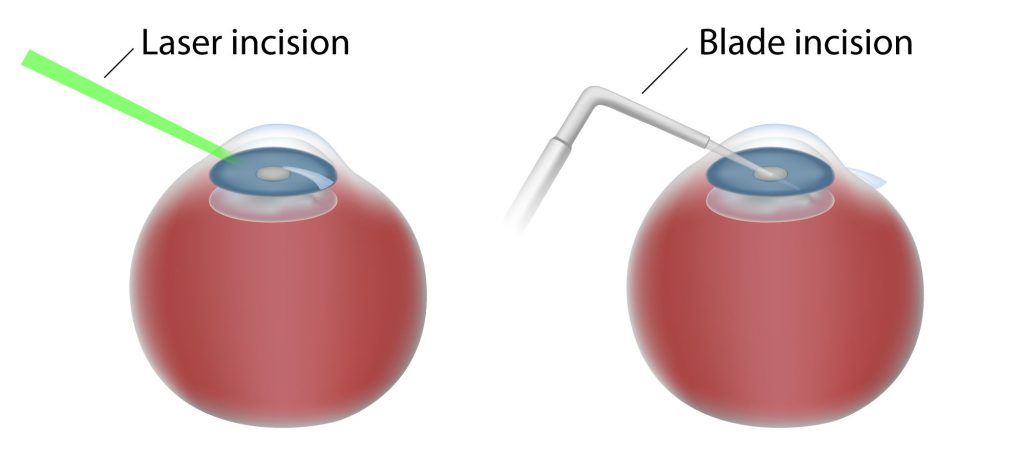Laser Technology for Cataract Treatment
One of the newest and most advanced technologies for laser-assisted cataract surgery offered at SightMD is the Catalys® Precision Laser System. The Catalys® laser is a technological marvel. Composed of an advanced laser, 3D Optical Coherence Tomography (OCT) imaging, and refined software. Together this provides optimal precision for highly customized cataract surgery.
This technology gives us even greater control over every phase of the procedure. From the removal of the cataract to the placement of a premium IOL. Our surgeons can target selected sites of the eye with absolute accuracy allowing them to leave surrounding healthy tissues undisturbed. Patients of SightMD have always had access to the safest, highest-quality cataract surgery available. The Catalys® system allows us to improve on that already high standard.
Benefits of The Catalys® Laser Vision Correction System
This remarkable laser system offers benefits over traditional forms of cataract surgery enabling us to:
- Make more precise incisions in the cornea to access the lens capsule
- Create a circular opening in the capsule that is ten times more accurate than is possible with hand-held tools
- Gently soften and segment the cataract so that it can be removed with less ultrasound energy than with traditional methods
- Place the IOL with greater precision after cataract removal
Because of these advancements, patents can experience:
- Faster healing times for precisely cut laser incisions
- Potentially lower risk of infection
- Improved and faster visual results over traditional cataract surgery
- Correction of astigmatism simultaneously
How the CATALYS® Laser Works
CATALYS® improves upon our already exceptional cataract removal techniques. The laser system allows our doctors to precisely execute each step of cataract surgery. From the initial planning stage to the placement of the intraocular lens (IOL)
Mapping and Customization
The CATALYS® features the Integral Guidance System™. This is an advanced optical coherence tomography (OCT) system that scans the eye. This scan creates a detailed 3D map so our surgeons can provide customized treatment. The Integral Guidance System™ allows our surgeons to target selected sites with absolute precision. While leaving the surrounding “safety zones” untouched. This technology works in conjunction with the Liquid Optics™ Interface. This interface docks to the patient’s eye throughout the surgery. Using a special liquid to fill in irregularities in the corneal surface together it provides our doctors with a clear view of the entire eye during each stage of treatment. This interface has minimized the rise in intraocular pressure during surgery while reducing contact between the system and the sclera to ease post-surgical redness.
Corneal Incisions
While a patient’s eye is under constant evaluation by the Integral Guidance System™, the CATALYS® Laser can begin the steps of treatment. The laser creates precise corneal incisions in the cornea to access the lens capsule. This capsule contains the cataract-affected lens. The CATALYS® Laser is also FDA approved to create side port incisions, allowing surgeons to improve the accuracy of cataract surgery.
Anterior Capsulotomy
Once surgeons make initial corneal incisions, the CATALYS® creates a circular opening in the lens capsule. Approximately 10 times more accurate than possible with hand-held tools used in traditional cataract surgery. Surgeons remove this part of the lens capsule, providing access to the cataract-affected lens.
Phacofragmentation
With the lens now accessible, the CATALYS® can soften and segment the lens in a grid pattern, allowing our surgeons to remove the cataract using hand-held tools and ultrasound energy. By contrast, in traditional cataract surgery the surgeon breaks the lens up using only ultrasound energy. Because it first softens and segments the lens, the CATALYS® allows our surgeons to take a more conservative approach, using far less ultrasound energy to remove the lens fragments. This may be conducive to a faster visual recovery.
Lens Placement
Following cataract removal, our doctors will implant an IOL within the eye to restore vision. Because of the precision incisions used during the removal of the cataract, our surgeons can place the IOL with a greater degree of accuracy. SightMD’s premium line of IOLs work excellently with the precision of the CATALYS® System. SightMD doctors use ORA Optiwave technology to analyze each eye’s unique characteristics and determine optimal IOL power.
Limbal Relaxing Incisions
In some cases, our doctors may also perform limbal relaxing incisions, performed during cataract surgery allowing surgeons to reduce astigmatism. These precise incisions refocus light entering the eye with more predictable outcomes, allowing for more successful vision improvement than with a handheld blade.
Am I a Candidate for Laser Cataract Surgery?
The best way to find out if laser cataract surgery is right for you is to schedule an eye examination. This will check your degree of vision loss and allow our doctors to make recommendations specific to your situation. Many individuals live with cataracts that do not impact their vision. Often, these people do not need cataract surgery. They may be able to manage the symptoms of early cataract by wearing new eyeglasses. Our doctors will likely advise you to treat your cataracts if your visual impairment becomes significant enough to interfere with your activities of daily living. Currently, cataract surgery is the only effective treatment. Patients who undergo cataract surgery to restore clear vision often experience a significant improvement in their quality of life.
Manual vs. Laser Cataract Surgery
Cataract surgery has been around for hundreds of years. Traditional cataract surgery is a manual process. Advancements in the field have replaced those demanding manual steps with laser-assisted technology. There are notable differences between the manual approach and the CATALYS® System. You can see them at each stage of your cataract surgery breakdown below:
- Step 1: Making the Incisions – To access the cataract, our surgeons need to make a few tiny incisions. With the manual approach, these incisions can be irregular. With the CATALYS® System, they are nearly perfect.
- Step 2: Preparing the Cataract for Removal – For the cataract to be smoothly removed through the small incisions, surgeons will divide it into smaller pieces. With the manual approach, the cataract is not pre-segmented, and surgeons break it into pieces that are random in size and shape. By contrast, the CATALYS® System easily pre-cuts the cataract into small, predictable segments.
- Step 3: Placing the IOL – After removing your clouded lens, our cataract surgeons will replace it with an artificial one called an IOL, or intraocular lens. This soft new lens will remain in your eye for a very long time, so surgeons must position it properly. Centering the IOL under the circular incision is the ideal placement. The CATALYS® System ensures that the alignment is precise.

A New Frontier in Cataract Surgery
The experts of SightMD have performed thousands of successful traditional cataract surgeries, which is still an excellent treatment option. For those patients who are exploring the next level of precision in this treatment, laser cataract surgery represents a new frontier. Our trusted eye care professionals are ready to answer your questions about laser cataract surgery, including its cost, the recovery period, and your candidacy.
What To Expect During Recovery
There are very few restrictions on what you can and cannot do as you recover from surgery. After your procedure, we will give you detailed post-op instructions. The main thing to avoid is rubbing your eyes. Surgeons discourage swimming and any contact sports. You may resume these activities after two weeks in most cases.
Contact SightMD today to schedule an appointment with one of our doctors to discuss your vision health at one of our convenient locations!

Why Fall Is the Perfect Time to Consider LASIK Surgery
For many, the fall season marks a time of change. As the leaves change color and the weather gets…

Answering the Most Common Questions and Concerns about LASIK
LASIK eye surgery is a popular procedure that offers the promise of improved vision without the need for glasses…

Latest Advances in LASIK Eye Surgery
LASIK eye surgery is a popular choice for correcting vision problems such as nearsightedness, farsightedness, and astigmatism. At SightMD,…